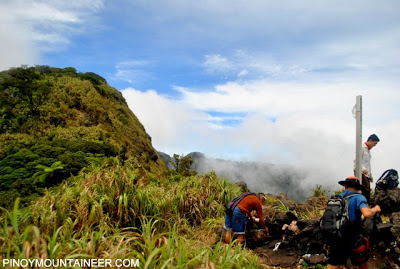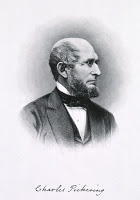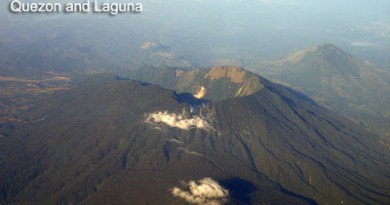Hikes in Philippine History #5: An account of a hike up Mt. Banahaw in 1842

 |
| Dr. Charles Pickering (1805-1878) |
annotated by Gideon Lasco
From the “Manila and Sulu in 1842” narrative by US Com. Chas. Wilkes, U.S.N. 459, volume 5 of his “Narrative of U. S. Exploring Expedition 1838-42”, we find an account of a hike up Mt. Banahaw by two members of the expedition, Dr. Charles Pickering and Lieutenant Henry Eld. Charles Pickering himself gives an account in his “The Races of Man”, and I have the pleasure of presenting both their accounts here as part of our “Hikes in Philippine History” series.
Interesting here is the use of the word “Maijaijai” to refer to the volcano, and the archaic spelling of Banahaw, “Banajao”. Also of interest is the fact that there is a small hut at the summit, and that there is an inhabited half-way point some three hours away from the peak. Is this the Tatlong Tangke Trail?
AN ACCOUNT BY COMMODORE WILKES
About noon they left Don Escudero’s, and took a road leading to the
southward and eastward, through a luxuriant and beautiful country,
well cultivated, and ornamented with lofty coconut trees, betel
palms, and banana groves. Several beautiful valleys were passed,
with streamlets rushing through them.
Maijaijai is situated about one thousand feet above the Laguna de Bay,
but the rise is so gradual that it was almost imperceptible.
The
country has everywhere the appearance of being densely peopled;
but no more than one village was passed between Santa Cruz and the
mission. They had letters to F. Antonio Romana y Aranda, padre of
the mission, who received them kindly, and entertained them most
hospitably.
Climbing Banajao
When he was told of their intention
to visit the mountain, he said it was impossible with such weather,
pointing to the black clouds that then enveloped its summit; and he
endeavoured to persuade the gentlemen to desist from what appeared
to him a mad attempt; but finding them resolved to make the trial,
he aided in making all the necessary preparations, though he had no
belief in their success.
On the morning of the 27th, after mass, Mr. Eld and Dr. Pickering
set out, but Mr. Sturges preferred to keep the good padre company
until their return. The padre had provided them with guides, horses,
twenty natives, and provisions for three days. He had been himself
on the same laborious journey, some six months before, and knew its
fatigues, although it turned out afterwards that his expedition was
performed in fine weather, and that he had been borne on a litter by
natives the whole way.
The first part of the road was wet and miry, and discouraging
enough. The soil was exceedingly rich, producing tropical plants
in great profusion, in the midst of which were seen the neat bamboo
cottages, with their industrious and cleanly-looking inhabitants. When
they reached the foot of the mountain, they found it was impossible to
ride farther, and were obliged to take to walking, which was, however,
less of a hardship than riding the little rats of horses, covered with
mud and dirt, which were at first deemed useless; but the manner in
which they ascended and maintained themselves on the slippery banks,
surpassed anything they had before witnessed in horseflesh.
The first
part of the ascent of the mountain was gradual, but over a miry path,
which was extremely slippery; and had it not been for the sticks stuck
down by the party of the padre in their former ascent, they would have
found it extremely difficult to overcome; to make it more disagreeable,
it rained all the time.
It took about two hours to reach the steep ascent. The last portion
of their route had been through an uninhabited region, with some
openings in the woods, affording pasture-grounds to a few small herds
of buffalo.
In three hours they reached the half-way house, by a very
steep and regular ascent. Here the natives insisted upon stopping
to cook their breakfast, as they had not yet partaken of anything
through the day. The natives now endeavored to persuade them it was
impracticable to go any farther, or at least to reach the top of the
mountain and return before night.
Our gentlemen lost their patience at
the delay, and after an hour’s endurance of it, resolved to set out
alone. Six of the natives followed them, and by half-past three they
reached the summit, where they found it cold and uncomfortable. The
ascent had been difficult, and was principally accomplished by catching
hold of shrubs and the roots of trees. The summit is comparatively
bare, and not more than fifty feet in width. The side opposite to
that by which they mounted was perpendicular, but owing to the thick
fog they could not see the depth to which the precipice descended.
The observations with the barometers were speedily taken, which gave
the height of Banajao as six thousand five hundred feet. The trees
on the summit were twenty or thirty feet high, and a species of
fir was very common. Gaultheria, attached to the trunks of trees,
Rhododendrons, and Polygonums, also abounded. The rocks were so
covered with soil that it was difficult to ascertain their character;
Dr. Pickering is of opinion, however, that they are not volcanic.
The
house on the summit afforded them little or no shelter; being a mere
shed, open on all sides, they found it untenantable, and determined
to return as soon as their observations were finished, to the half-way
house, which they reached before dark.
The night was passed uncomfortably, and in the morning they made
an early start down the mountain to reach the native village at its
foot, where they were refreshed with a cup of chocolate, cakes, and
some dulces, according to the custom of the country.
At ten o’clock
they reached the mission, where they were received by the padre and
Mr. Sturges. The former was greatly astonished to hear that they
had really been to the summit, and had accomplished in twenty-four
hours what he had deemed a labor of three days. He quickly attended
to their wants, the first among which was dry clothing; and as their
baggage had unfortunately been left at Santa Cruz, the wardrobe of
the rotund padre was placed at their disposal. Although the fit was
rather uncouth on the spare forms of our gentlemen, yet his clothes
served the purpose tolerably well, and were thankfully made use
of.
EXCERPTS FROM AN ACCOUNT BY DR. CHARLES PICKERING
There had been continual rains on the mountain of
Banajao ; but, in the midst of discouraging accounts, it was
decided to make the ascent. The horses brought for us were very small, and of most unpromising appearance, and
we were surprised at the good, service they rendered. The
same small breed is found in the other East India islands,
and, together with the buffalo, is of aboriginal introduction.
These two were the only new domestic animals thus far met
with in voyaging westward ; for the hillock, which was rare,
appeared to have been first made known in this part of the
East Indies by Europeans.
After passing through the inhabited region, we arrived at
tie woods, where the acclivity was too steep for horses ; and
it was now a work -of five hours to reach the summit, which
is the highest point of the island, being about sit thousand
five hundred feet above the sea. It was here very cold, and
the rain still accompanying us, we did not remain longer
than was necessary to complete the observations; but so
much time had been lost through the mismanagement of our
guides, that we were obliged on our way down, to pass the
night at the half-way station.
There was but little shelter there from the heavy rain ; and our large company of natives, unlike the Polynesians and aboriginal Americans, proved
utterly helpless in an emergency. They slept very
little during the night; but though nearly naked, having
their skin inured to exposure, they were probably in less
danger than ourselves of an attack of acute disease.
We were glad to leave on the first appearance of light,
and finding our horses at the place where we had left them,
we mounted, and before noon again arrived at the Mission.
In the afternoon, we returned to Santa Cruz, and embarking in our canoe, spent another night upon the lake. We
landed early on the morning of the 19th, at the hot spring
of Banos, and after remaining awhile, again set out with a
fresh but not altogether favourable breeze. Notwithstanding
we had the assistance of paddles, one of the large narrow
canoes used on this lake, having a double out-rigger, went
to the windward of us with ease. Before dark, we reached
the village at the outlet, where a theatre was said to be
“kept open during the holidays;” and having now the
current in our favour, we proceeded at a rapid rate, and
landed in the city at an early hour in the evening.



Leave a Reply
1 Comment on "Hikes in Philippine History #5: An account of a hike up Mt. Banahaw in 1842"
Good job! History proved that patience and perseverance will lead you to greater heights. To go up to Mt. Banahaw or Banajao costs a lot of planning and handwork. In my case, my desicion of traveling costs me a lot of considerations. One factor is how to get over jet lag. When I found my anti jet lag, jetLAGFX http://www.jetlagfx.com/, I was relieved. More power to your journeys!